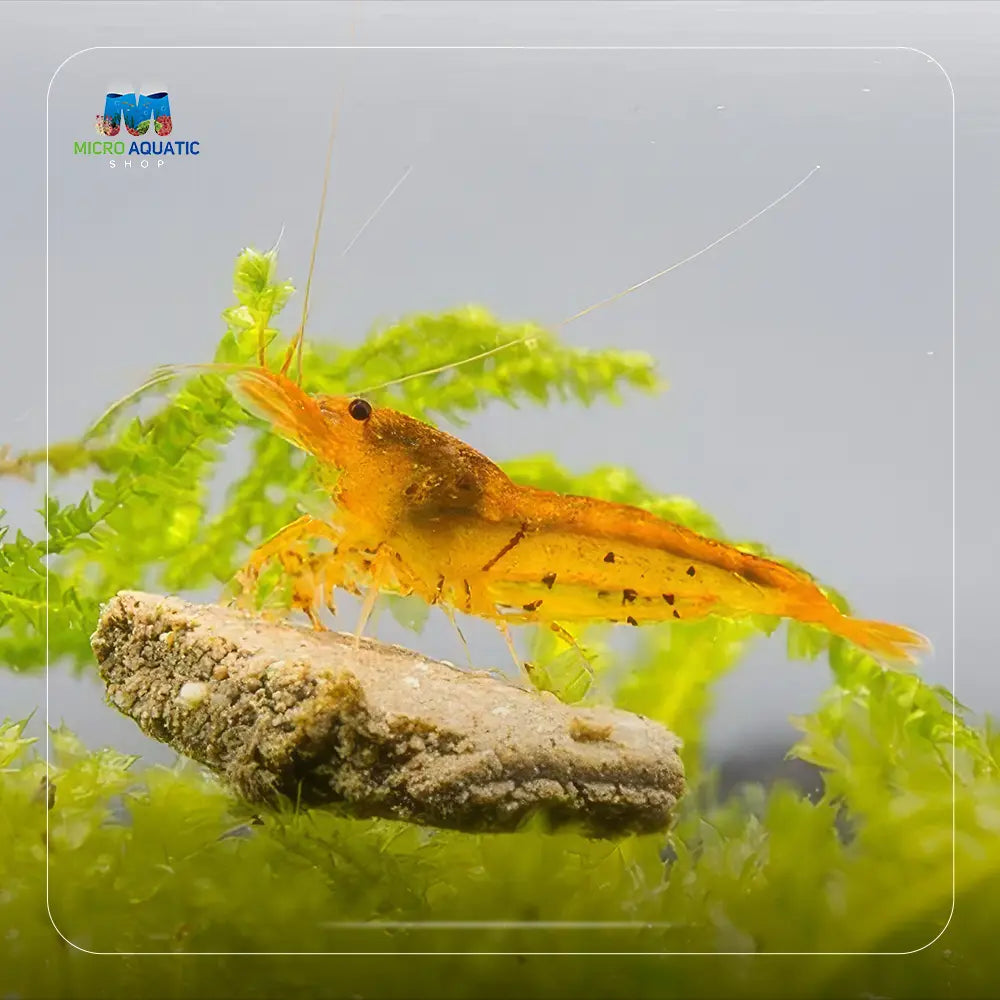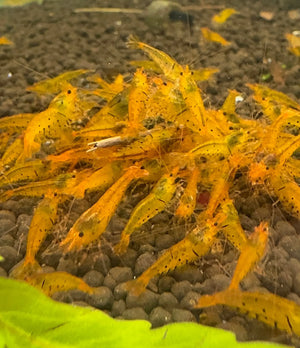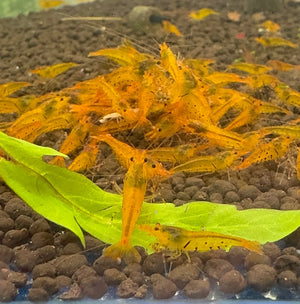Tiger Shrimp -Tangerine
Order today - receive it in as little as 3-5 days.
Return within 30 days of purchase. Duties & taxes are non-refundable.
Guarantee Safe Checkout

Tiger Shrimp -Tangerine
Tangerine Tiger Shrimp - Vibrant Orange Shrimp for Stunning Aquariums
Explore the world of Tangerine Tiger Shrimp, the stars of freshwater aquariums. These vibrant orange crustaceans are a joy for both new and experienced aquarium lovers. They bring stunning colour and lively behaviour to your tank, enhancing its beauty and balance.  Coming from tropical areas, these shrimp are not just beautiful. They also keep your tank clean by eating algae. Their special eating habits and calm nature make them great friends for many fish and invertebrates.
Coming from tropical areas, these shrimp are not just beautiful. They also keep your tank clean by eating algae. Their special eating habits and calm nature make them great friends for many fish and invertebrates.
Key Takeaways
- Tangerine Tiger Shrimp are known for their vibrant orange colouration, making them a stunning addition to any aquarium.
- These shrimp are natural algae eaters, helping to maintain the cleanliness and balance of your aquatic environment.
- Tangerine Tiger Shrimp are easy to care for and can be kept with a variety of compatible tank mates.
- With their engaging behaviour and low maintenance requirements, these shrimp are a popular choice for both experienced and novice aquarium enthusiasts.
- Properly setting up and maintaining the ideal tank conditions is crucial for the long-term health and wellbeing of Tangerine Tiger Shrimp.
Understanding Tangerine Tiger Shrimp: Origins and Characteristics
Tangerine Tiger Shrimp, or caridina cf. cantonensis, are a fascinating species of dwarf shrimp. They have won the hearts of many aquarium lovers around the world. These colourful crustaceans come from the warm, tropical areas of Southeast Asia. They live in pristine natural places.
Natural Habitat and Distribution
Tangerine Tiger Shrimp are found in various freshwater places in countries like China, Taiwan, and Vietnam. They love slow-moving streams, rivers, and marshes. These places offer them plenty of hiding spots among the plants and gravel.
Physical Characteristics and Colouration
These shrimp are known for their bright orange-and-black stripes. This gives them a unique "tiger" look. Their colours come from a mix of their genes and their environment. Some shrimp have even brighter colours than others.
Size and Growth Patterns
Tangerine Tigers are small, reaching about 2-3 cm (0.8-1.2 inches) in length. Their size and how they grow depend on things like water quality, food, and their surroundings. This can be in their natural home or an aquarium.
| Feature | Description |
| Scientific Name | caridina cf. cantonensis |
| Common Names | Tangerine Tiger Shrimp, Dwarf Shrimp, Nano Shrimp |
| Natural Habitat | Slow-moving streams, rivers, and marshes in Southeast Asia |
| Colouration | Vibrant orange-and-black striped patterns |
| Maximum Size | 2-3 cm (0.8-1.2 inches) |
Setting Up the Perfect Tank Environment
Creating the perfect tank environment is key for our aquarium invertebrates, the Tangerine Tiger Shrimp. As fans of freshwater shrimp, we know how important it is to mimic their natural habitat. This ensures their colours stay bright and they stay active in our nano shrimp tanks. For substrate, a fine grain sand or gravel is best. It looks like the river beds where Tangerine Tiger Shrimp live. Adding live plants like Java Moss, Anubias, and Cryptocoryne makes the tank look great. It also gives our shrimp places to hide and eat.
- Fine grain sand or gravel substrate
- Java Moss, Anubias, and Cryptocoryne plants
- Hiding spots for shrimp to retreat to
Along with substrate and plants, we need the right equipment. A well-planted tank helps beneficial bacteria grow. This creates a stable home for our shrimp. Giving them plenty of space to graze and gentle water flow helps them thrive. "Creating the perfect tank environment is the first step in providing our Tangerine Tiger Shrimp with the optimal conditions to showcase their vibrant colours and natural behaviours." By carefully planning our tank setup, we make our aquarium invertebrates, the Tangerine Tiger Shrimp, feel at home. With the right substrate, plants, and equipment, we can create a lively freshwater shrimp community. This community will amaze us with their stunning beauty.
Water Parameters and Maintenance Requirements
Keeping the water right is key for our brackish shrimp, freshwater shrimp, and other aquarium invertebrates. For Tangerine Tiger Shrimp, we must watch the temperature, pH, and water hardness closely. This ensures they do well in our underwater world.
Optimal Temperature Range
Tangerine Tiger Shrimp like a temperature between 22-26°C (72-79°F). This range helps them stay healthy and bright orange. We need a good heater to keep the water just right.
pH and Water Hardness
The pH for Tangerine Tiger Shrimp should be slightly acidic, between 6.5 to 7.5. They also do well in water that's not too hard, with a general hardness (GH) of 6-12 dGH. Keeping these levels right helps our shrimp stay healthy and grow well.
Water Change Schedule
- Change 20-25% of the water weekly to add minerals and remove waste.
- Use a gravel vacuum to clean the substrate and keep the water fresh.
- Add dechlorinator to the water to make it safe for our shrimp.
By keeping the water right and sticking to a regular care routine, we can give our Tangerine Tiger Shrimp the best home. They'll thrive and show off their bright colours in our aquarium.
Dietary Needs and Feeding Guidelines
Tangerine Tiger Shrimp need a special diet to stay healthy and colourful. They eat algae and clean up the tank. This makes them important in the aquarium. It's key to feed them a variety of foods. This includes:
- High-quality algae wafers or discs
- Blanched and chopped veggies like zucchini, spinach, and carrots
- Sinking pellets or powder made for shrimp
- Now and then, treats like cooled lettuce or cucumber
These shrimp love to eat leftover fish food and decaying plants. But, they also need shrimp-specific foods. This ensures they get all the nutrients they need.  Feed them small amounts often, not big meals less often. Aim for two to three meals a day. This keeps the tank clean and the shrimp healthy. "Proper feeding is essential for the long-term well-being and stunning appearance of Tangerine Tiger Shrimp in the home aquarium." Knowing how to feed your ornamental shrimp is crucial. It helps your dwarf shrimp and freshwater shrimp live well in their home.
Feed them small amounts often, not big meals less often. Aim for two to three meals a day. This keeps the tank clean and the shrimp healthy. "Proper feeding is essential for the long-term well-being and stunning appearance of Tangerine Tiger Shrimp in the home aquarium." Knowing how to feed your ornamental shrimp is crucial. It helps your dwarf shrimp and freshwater shrimp live well in their home.
Breeding and Reproduction Cycle
Breeding caridina cf. cantonensis, or Tangerine Tiger Shrimp, is a thrilling experience for aquarium lovers. These colourful nano shrimp can reproduce well in the right tank. This lets hobbyists keep healthy populations of these invertebrates.
Mating Behaviour
The mating of Tangerine Tiger Shrimp starts with the female releasing pheromones to attract males. Males then perform a courtship dance to check if the female is ready. After the female molts, the male fertilizes her eggs. She carries these eggs under her tail until they hatch.
Caring for Shrimplets
- Shrimplets need careful care and a safe environment to grow.
- Keep the water perfect, with stable temperature, pH, and oxygen levels.
- Feed them a mix of high-quality foods like powdered algae and crushed veggies.
- Make sure they have plenty of places to hide, like moss or fine-leaved plants.
Population Management
To keep a healthy and varied Tangerine Tiger Shrimp population, you need good population management:
| Technique | Description |
| Selective Breeding | Pick breeding pairs to keep good traits and avoid inbreeding. |
| Culling | Take out any deformed or sick shrimp to keep the population quality high. |
| Regular Partial Water Changes | Do regular water changes to keep waste levels down and water quality up. |
Knowing how Tangerine Tiger Shrimp breed helps aquarium fans grow vibrant colonies. They can enjoy the stunning beauty of these caridina cf. cantonensis in their tanks.
Compatible Tank Mates and Community Setup
Choosing the right tank mates is key for keeping vibrant orange shrimp, like the Tangerine Tiger Shrimp, happy in your aquarium. These ornamental shrimp thrive with peaceful, non-aggressive tank mates. This ensures they won't be seen as food. For freshwater shrimp lovers, pairing Tangerine Tiger Shrimp with other peaceful shrimp is a great idea. Crystal Red Shrimp or Amano Shrimp make excellent companions. They live well together, sharing the same space and foraging habits.
| Tank Mate | Compatibility Level | Notes |
| Crystal Red Shrimp | High | Peaceful, non-aggressive species that thrive in similar water parameters. |
| Amano Shrimp | High | Gentle, algae-eating shrimp that make excellent companions. |
| Dwarf Corydoras Catfish | Moderate | Bottom-dwelling fish that coexist peacefully with orange shrimp. |
| Platies | Low | Peaceful, community-friendly fish, but may occasionally nibble on shrimp. |
Stay away from aggressive or predatory fish like Bettas or Angelfish. They might see the orange shrimp as a snack. Building a harmonious community tank needs careful thought about the shrimp's needs and tank mate compatibility. With the right environment and tank mates, you can enjoy the stunning colours and lively behaviour of Tangerine Tiger Shrimp. This will help create a thriving, balanced aquatic ecosystem in your home.
Common Health Issues and Prevention
Keeping our Tangerine Tiger Shrimp healthy is key for their long life and our aquarium's success. As shrimp lovers, we must watch for health problems and take steps to prevent them. This helps our dwarf shrimp stay happy and healthy.
Disease Recognition
White spot disease, or "Ich," is a big problem for Tangerine Tiger Shrimp. It shows up as white spots on their bodies and can spread fast if not treated. Shell deformities are another issue, often caused by mineral deficiencies or water imbalances.
Treatment Options
Acting fast is important when disease strikes. For white spot disease, raising the water temperature and using copper-based meds can help. For shell issues, fixing water quality and adding calcium and minerals to their diet can help.
Preventive Measures
- Keep water parameters like temperature, pH, and hardness stable for a healthy environment.
- Change water regularly and clean the substrate to avoid waste buildup.
- Quarantine new shrimp before adding them to the main tank to stop disease spread.
- Feed a balanced diet full of nutrients to keep our shrimp healthy.
By being alert, treating problems quickly, and taking preventive steps, we can keep our Tangerine Tiger Shrimp thriving. This way, we can enjoy their beauty in our aquariums for years to come.
Conclusion
The Tangerine Tiger Shrimp is a standout in any freshwater aquarium. These orange shrimp are not just beautiful; they also help keep the tank balanced. They're great for both experienced and new aquarium lovers.  Creating a natural habitat and the right water conditions is key. This way, these freshwater shrimp will flourish. They add beauty and help clean the tank, making them essential for a lively aquarium. Adding these vibrant creatures to your tank is a great idea. With the right care, you'll enjoy a stunning display of colour. Plus, you'll have a thriving shrimp colony that's fun to watch.
Creating a natural habitat and the right water conditions is key. This way, these freshwater shrimp will flourish. They add beauty and help clean the tank, making them essential for a lively aquarium. Adding these vibrant creatures to your tank is a great idea. With the right care, you'll enjoy a stunning display of colour. Plus, you'll have a thriving shrimp colony that's fun to watch.
FAQ
What are Tangerine Tiger Shrimp?
Tangerine Tiger Shrimp, also known as Orange Shrimp, are a stunning freshwater shrimp species. They belong to the Caridina cf. cantonensis group. These vibrant crustaceans are a popular choice among aquarium enthusiasts for their captivating orange colouration and compact size.
Where do Tangerine Tiger Shrimp come from?
Tangerine Tiger Shrimp originate from brackish water habitats in Southeast Asia. They come from regions like Taiwan and Hong Kong. They thrive in well-established aquarium environments and have become a favourite among hobbyists for their unique appearance and role in maintaining healthy aquarium ecosystems.
How big do Tangerine Tiger Shrimp grow?
As dwarf or nano shrimp, Tangerine Tiger Shrimp typically grow to a maximum length of around 2.5 centimetres. Their compact size makes them well-suited for small to medium-sized aquariums and nano tanks.
What kind of tank setup do Tangerine Tiger Shrimp require?
Tangerine Tiger Shrimp thrive in well-established, heavily planted aquariums. They need a suitable substrate, hiding spots, and a stable water environment. They prefer a slightly acidic to neutral pH, with moderate water hardness and consistent temperatures between 20-26°C.
What do Tangerine Tiger Shrimp eat?
As omnivores, Tangerine Tiger Shrimp are excellent algae eaters and scavengers. They'll happily consume a variety of algae, plant matter, and sinking shrimp pellets or powdered foods specifically formulated for these delicate invertebrates.
How do Tangerine Tiger Shrimp breed?
Tangerine Tiger Shrimp have an interesting breeding cycle. Females will carry their eggs underneath their tails until the young shrimp, known as "shrimplets," hatch. Maintaining the right water parameters and providing hiding spots is crucial for successfully breeding and raising these colourful crustaceans.
What other tank mates are suitable for Tangerine Tiger Shrimp?
Tangerine Tiger Shrimp do best in community tanks with peaceful, non-aggressive fish and shrimp species. Some compatible tank mates include other dwarf shrimp, small tetras, rasboras, and certain types of snails. It's important to avoid any potential predators that may see the shrimp as food.
How can I keep my Tangerine Tiger Shrimp healthy?
Maintaining optimal water parameters, providing a varied diet, and performing regular partial water changes are crucial for keeping Tangerine Tiger Shrimp healthy. Additionally, monitoring for any signs of disease and treating them promptly can help prevent issues and ensure the long-term wellbeing of your shrimp.
| Qty |
3 juvie 1 cm, 1 juvie 1 cm |
|---|









